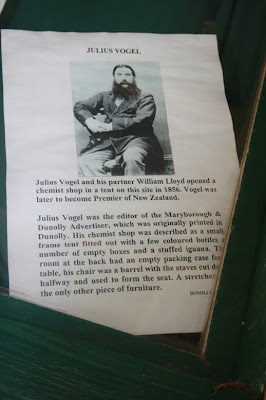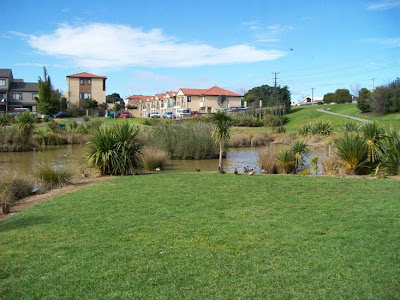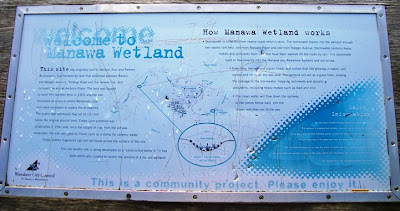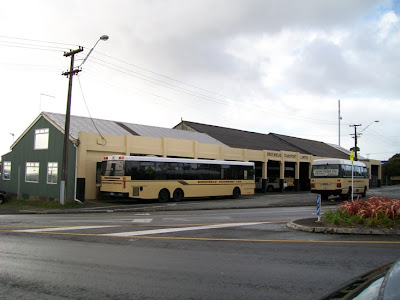Since the last day of racing (for at least a while, hopefully) at Avondale, I've been gathering together a bit of a snippets list of items about the progress of the Avondale Jockey Club from when it kicked off with entry off Wingate Street and essentially half a track, down to just before World War I. I'll see about adding more as I go later.
1890
A new racing club has been formed in the Avondale district, and the opening gathering is to be held on the 26th prox. The promoters have secured a capital course in close proximity to the township, and I understand that tenders are to be at once called for the erection of a grand stand.
Otago Witness 20 March 1890
Splendid nominations have been received for the different events of the inaugural meeting of the Avondale Jockey Club, which takes place at Avondale on Saturday, April 26th. No less than 20 entries have been received for the Avondale Cup, Maiden Plate, and Pony Race, while 22 are engaged in the Flying Stakes, 19 in the Welter Handicap, and 9 are on the list for both the Hurdle Race and Steeplechase. Acceptances are due on Friday.
Observer, 19 April 1890
The Avondale Jockey Club bring off their inaugural race meeting on Saturday, and there is every prospect of it being an unqualified success. Last Friday afternoon a large number of sportsmen paid a visit to the course, and all were greatly pleased with the excellent piece of ground on which it is situated. The track is egg-shaped, and on each side there is a fine straight of 380 yards long. In circumference it measures about fifty yards short of a mile. The steeplechase course is over a flat country, and the jumps are natural ones, being composed of gorse and bank, and the spectators will have a full view of the competitors all the time. A grandstand is being erected, which will be capable of holding 400 people. There are all the necessary conveniences, such as jockey's room, weighing-room, stewards' and ladies' rooms, also a convenient bar. The committee are leaving no stone unturned to make the meeting a success, and it only needs fine weather to see a large attendance assembled on the pretty course on Saturday. The public will be able to obtain through tickets (including admission to the course and rail) for 2s, and I may also remark that the railway crossing is only about 300 yards from the course. The acceptances received are first-class, and a good day's sport is assured.
Observer, 26 April 1890
The Avondale Spring Meeting attracted about 600 spectators last Saturday, but the heavy downpour of rain interfered somewhat with the afternoon's pleasure. Then again there were several unfortunate protests, which occasioned a good deal of bad feeling. Mr Hayr, the secretary, worked very hard to bring about a successful meeting, but events seemed to conspire against him.
Observer, 20 December 1890
1891
Onslow Trotting Club
A special meeting of this club was held a few days ago at the office of Mr McBride, for the purpose of choosing a suitable racecourse. Several offers had been received, and the choice was narrowed down to two. One of these was the property of Mr George Wright, at Kohimarama, but the difficulty of reaching this place stood in the way of its acceptance. The other offer of a racecourse was from Mr Bollard, of Avondale, who offered 22 acres of land adjoining the other course. As extensive and costly improvements would have to be carried out, the Committee deferred consideration.
Observer, 8 August 1891
1892
The Avondale Jockey Club had a most lucky time, in so far as the weather cleared up beautifully. It proved a regular autumn day peculiar alone to New Zealand. I can hardly compliment the management on keeping good time, but an excuse can be offered in the way of protests. Two of these came from owners of ponies, and I must say that until the Auckland Racing Club issue certificates these protests are likely to be continued, and not entirely with justification, as there are several so-called ponies running in this district that are considered over the standard. Mr H. Hayr, as secretary, did lion's work, as also did Mr K. Garrett. The latter gentleman had no easy task in picking the winner of the last race, which was run in the dark. However, he gave every satisfaction. Big dividends were the order of the day, and Messrs Adams and Andrews passed £2069 through the machine during the afternoon. Several of our leading racing men take objection to the handicapper acting as starter. One of our oldest racing men, Mr J. Lennard, was carpeted for giving the starter a bit of his mind. I do not uphold Mr Lennard losing his temper, but all the same it is not quite the "cheese." The Maiden Steeplechase was notable inasmuch as the only horse that cleared his jumps won. The others all fell, but luckily no one was hurt.
Otago Witness, 14 April 1892
The Avondale Racing Club are forming a trotting club. With no pony racing allowed it is sure to be a success.
Otago Witness, 18 August 1892
1893
The Avondale Jockey Club's Autumn meeting was held on Saturday at the course, Avondale. In consequence of the threatening appearance of the weather in the morning there was only a moderate attendance of the public. Though the fields were small, there was good racing. Mr H. H. Hayr was secretary, Mr H. Cutts starter, Mr Ballard judge, Mr J. R. Cooke timekeeper, Mr R. W. Marks clerk of scales, and Mr Creighton clerk of course. The sum of £1700 was invested by means of the totalisator, which was worked by Messrs Andrews and Adams. The Waikomiti band was present, but was a very poor attraction.
Otago Witness, 27 April 1893
At the Avondale Jockey Club race meeting on Saturday there was no totalisator but books in force, the absence of which at a general race meeting showed the public that racing had no attractions without the machine. Only 350 were present at the meeting.
Grey River Argus, 26 September 1893
1894
The Avondale Jockey Club's Autumn meeting was held on Saturday. The weather, threatening in the forenoon, broke during the afternoon, and the rain that fell considerably interfered with the day's sport. Mr J. Bollard held the office of judge, and Mr E. D. Halstead wielded the starter's flag with every success. The totalisators were worked by Messrs Andrews and Anderson. Out of respect to the memory of Mr R. Garrett, who with Mr M. Foley originated the Avondale Club, the officers and jockeys wore crepe on their arms.
Otago Witness, 19 April 1894
1895
Racing up here last Saturday was provided by the Avondale Jockey Club which conducted an experiment in connection with the autumn gathering by holding it without a totalisator. The bookmakers were the only betting medium. It cannot be said that the experiment proved a success. The fields were rather scanty, but even with that drawback given in the prices offered by the ring can't be said to have been a strong argument why the totalisator should be suspended.
Otago Witness, 14 February 1895
Sir Patrick Buckley has after all resigned his political office for the serener occupation which was offered to him, and he is now a judge. One of his last acts before walking out of his old department was to send notification to the Avondale Club (Auckland) that a totalisator license would not be issued for a second meeting by this club during the current season. This has caused considerable dissatisfaction. The Avondale Club was allowed two meetings a year by the conference arrangement, and, acting in the belief that that allocation would be carried out, the club gave £300 in stakes at its Spring meeting. For one meeting a season only £150 is required, and the extra £150 was thus thrown away. This is very annoying. The Colonial Secretary should make up his mind at the beginning of a season and agree to or proclaim or in some way let it be known what he is going to do. Few clubs are so well off as to be able to lose £150 without feeling it. In this case the sum stated might as well have been pitched overboard. It may be supposed that the omission to give a word of caution on the subject was an act of thoughtlessness on the Colonial Secretary's part. We cannot suppose that he would perpetrate such an injustice wantonly. But Ministers are placed where they are by the public for the express purpose of thinking out the equitable administration of the law, and forgetfulness is not a full excuse for the neglect of that duty. Whoever is to blame deserves a smart rap over the knuckles for his carelessness in this matter, and it must be the Colonial Secretary who is responsible to the public. He may find out for his own satisfaction whether any of his subordinates are in the wrong. With them we have nothing to do. This Avondale case may happen again to some other club unless some safeguards are adopted, and in view of that possibility our racing authorities should lose no time in coming to a full understanding on the subject, if such is possible. I do not know whether it is.
Otago Witness, 26 December 1895
1895
Avondale Club has showed its regard for the services rendered them by Mr Frank Lawry, M H R., by presenting him five days back with a gold medal bearing the monogram of the club and the inscription “Life member's ticket." Mr Lawry's last service to the club was to obtain for it a totalisator permit for its forthcoming meeting after the Premier had stated that one could not be granted. It is always advisable to have a parliamentary friend at court.
Otago Witness, 30 April 1896
1897
In spite of strenuous efforts on the part of the Auckland Racing Club authorities to obtain a fifth totalisator permit the Colonial Secretary has refused to budge from his resolution to limit each metropolitan club to four permits during the season, so that the proposed race gathering at Ellerslie next month has fallen through …
When it became known that the A.R.C. would be unable to race next month, the Avondale Club issued a two day programme for September 18 and 22.
Otago Witness, 2 September 1897
1898
The curtain was raised on the '98-99 racing season on Saturday afternoon, when the Avondale Jockey Club inaugurated its two days' Spring meeting. Fine weather favoured the club, and the attendance was something like 4000, which, with £3436 passed through the tote, presented a brace of records for the Avondale gathering. The ground was a bit holding, bat otherwise in good order.
Observer, 20 September 1898
1899
The Avondale Jockey Club had a great meeting fox the wind-up of their season. Favoured by fine weather on both days, a large attendance was attracted to the Western suburb on each occasion; but Saturday was especially a bumper day for the Club. The improvements to the course at Avondale were much appreciated. The saddling paddock is now roomy enough for anything, but if racing continues to go ahead with the same rapid strides as it has been doing lately, the Avondale Club will need a still larger stand. In respect to the totalisator figures, one can hardly believe the great increase (£5301) in the amount handled last week to that of the corresponding fixture last season. The increase is equal to a good day's total investments.
Observer, 29 April 1899
The committee of the Avondale J.C. unfolded a very satisfactory state of affairs to the members who attended the annual meeting on Friday last. The report showed that the club had made great strides during the past 12 months, the revenue showing in marked increase from all sources, the totalisator returns for the two meetings held totting up to £15,072, as against £8833 for the preceding year, while the added money given away was set down at £1283 10s net. Close on £900 had been spent on improvements to the course, and saddling paddock, loose boxes, grand stand, etc., and the assets were shown as £1160 over liabilities as against £586 last year. Secretary H. H. Hayr was given a pat on the back all round for the manner in which he had carried out his duties. The chairman (Mr M. Foley) said a lot of nice things in a general way, winding up by urging the incoming committee to exercise economy during the next couple of years with a view to purchasing the ground which is held under a lease with a purchasing clause.
Otago Witness, 17 August 1899
Amid the general prosperity that has attended racing, the Avondale Jockey Club has deservedly attracted to itself some share. A comparatively young club, it still has had vicissitudes. The last few seasons, however, have been ones of steady progress. The club now has a strong position, both in its constitution and in the favour of the public, a position that it owes to a careful though by no means cramped management; management having for its aim, not alone greater inducement to horse owners, but also the greater convenience and comfort of the racing public.
With the Avondale Jockey Club again this year will rest the honour of opening the season. That honour has come to be an annual one to the Avondale Club. I do not know if there be any special advantage accruing to a club through its having secured the earliest and opening dates. First meetings as a rule sound the key note of the whole year's performance. When we get into full swing we take any slight variations as a matter of course. I hope that the Avondale Jockey Club may open play to a measure lively and unrestrained, a prognostic of a good, enjoyable and successful season.
Observer, 26 August 1899
1900
The annual meeting of the Avondale Jockey Club was held on Friday last, when the report) and accounts laid before members showed that the club had made a great forward move last year, for after increasing the added money by £4148, and spending £222 in improvements, the suburban authorities showed £950 in the bank as against £62 the previous year, with assets £2271, and liabilities nil. Further improvements are under consideration, and the chairman, Mr M. Foley, in his remarks, indicated that the club would shortly effect the purchase of the course at Avondale, with probably some additional ground for present or future extension of the property. Secretary Harry H. Hayr, who, beyond a bonus or two, has "acted as an honorary official for some years, was made the subject of flattering reference, and the club decided to show its appreciation of his services by appointing him paid secretary at £150 per annum; while the fees of the handicapper (Mr J. O. Evett) were also increased substantially.
Otago Witness, 16 August 1900
1901
At the last monthly meeting of the Auckland Racing Club it was decided, owing to the improvements to the Avondale course being backward, to permit the club to use the Ellerslie course for their autumn meeting.
Taranaki Herald, 7 March 1901
The improvements to the Avondale Jockey Club's course, new stand, etc., are now well forward and should be ready for the club's Spring meeting. A tender has now been accepted for the addition of a stewards' stand.
Otago Witness, 17 July 1901
A copy of the Avondale programme for the coming season has reached us. The programme is got up in book form, and has a very racy appearance. The colour of cover is a deep red, and has a gold horseshoe stamped on it, and the printing inside is carried out in colours. Although the ornamental is strongly in evidence, the usefulness of the book is also well looked after. The Avondale Club intend holding seven days' racing in the forthcoming season, their first meeting being a three day*' one, and held on September 21, 25, and 28. The Autumn meeting is fixed for April 19 and 23 and the Winter gathering on June 14 and 18. A list of the winners of the principal races has been compiled, and the w.f.a. scale also find a place in the book. As an illustration of the progress of the club, it may be mentioned that in the season of '90-'9l the club gave away in stales £495, and in the coming season, '01-'O2, the added money will be £4325.
Otago Witness, 31 July 1901
1902
For a very considerable time there has been no racing at Avondale course. The increased popularity of the Avondale Jockey Club's fixtures rendered it necessary for the better enjoyment of the sport by their patrons, the public, to completely alter the existing course arrangements, alterations which involved a change of venue for the Club’s meeting for a whole season.
Extensive improvements and alterations had already been made when the Club were awakened to the fact that something still more radical in the way of change and extension was necessary to successfully cater good racing to the public, and being, fortunately, able to obtain the additional land required for the completion of such an extensive change, they set about it right away, and now have a racecourse property as thorough in its appointments as any suburban club can boast. All that is now needed to complete its up-to-date character is a faster train service to and from the course, and that desideratum is well on its way towards being fact. Old-timers would not recognise Avondale as it is now, and even turfites who have participated in racing there as it was at the time of its last meetings will find everything changed. The racecourse buildings are on the reverse side, the running has been changed from left to right, the course itself greatly improved, and in general, an "ensemble" quite different to their experience.
All this has meant expenditure of a large sum of money and also means the continued expenditure, on a higher scale than of old, for up-keep. But the Club's prospects arc bright and assured, and under the new conditions, whilst racing continues to prosper in the North, there is every reason to predict for the Avondale Club a successful future. The changes effected are conducive in every way to higher class racing, greater enjoyment of sport, benefiting all who participate, owners and public alike.
Observer, 19 April 1902
Avondale Jockey Club have small prospect of being able to bold an extra meeting this year, though they have placed it on their programme, in the hope of a permit becoming available. Everything comes to those who wait long enough, and the Avondale Jockey Club, if they hold out long enough, will yet get their three fixtures a year.
Observer, 16 August 1902
1907
It appears that, legally, not more than three totalisator machines can be used in connection with any race meeting, but this law has been repeatedly broken, both by Auckland and Avondale racing clubs, the impression being that as only one dividend was declared there was no breach of the law. In the Police Court to-day the Avondale Jockey Club and Secretary, H. Hayr, were separately charged with using three machines in excess of the law at each day of the last race meeting. The offence was admitted, but as very short notice had been given the Magistrate did not impose any penalty beyond the payment of costs.
Feilding Star, 28 October 1907
1908
Pony races are to be expunged from future Avondale programmes.
During the forthcoming season, the Avondale Jockey Club will give, in added money, the sum of £4000. This sum represents an increase of £400. The stake for the Avondale Cup is to be raised to 300 sovs., Plumpton Handicap to 200 sovs., and Avondale Handicap to 200 sovs.
Observer, 18 July 1908
The Avondale Jockey Club set the ball rolling on Saturday afternoon with the first instalment of the spring meeting, which extends over three days. The weather was perfect, the attendance large, and speculation brisk, the surn of £8352 being passed through the tote, an increase of £422 on the figures for the corresponding day last year. Twenty-five bookmakers plied their calling, and the club's coffers benefitted to the extent of £262 10s in fees from that source.
Otago Witness, 23 September 1908
In addition to the hotels affected by this decision of the electors, the Avondale Jockey Club will be unable, after June 30th, to have liquor for sale at their racecourse on racing days.
Wanganui Herald, 19 November 1908
1910
Good headway is being made by the contractor for the Avondale Jockey Club’s new stand, and it is anticipated that the whole structure will be finished well within contract time, despite the wretched weather that Auckland has experience for the last few weeks.
NZ Truth, 13 August 1910
A new members' stand is being erected for the Avondale Jockey Club. Contractors, A. Pollard & Son Price, £1000.
Progress, 1 September 1910
1911
At the suggestion by the Citizen's League, the Jockey Club applied to the Minister of Internal Affairs to change their scheduled meeting from Wednesday 26 April, to 29 Aperil, so as not to clash with the municipal and Auckland Harbour Board elections.
Evening Post 19 & 20 April 1911
The Avondale Jockey Club have decided to hold, their Spring meeting this year on September 20 ad 23. In previous years, the Avondale Club started the northern racing season with a three-day meeting, but as the Racing Commission has recommended that this popular suburban club must be docked one of its five days' racing— as a peace offering to Wowserism — the committee have been reluctantly compelled to reduce the Spring fixture to a two-days' meeting.
NZ Truth, 8 July 1911
















































.jpg)

















